Corsair Voyager A1600 review: Corsair’s first laptop is full of potential
Expert’s Rating
Pros
- 240Hz display with good motion clarity
- Excellent keyboard and touchpad
- Strong processor performance
Cons
- Game performance relies on annoying ‘Extreme’ mode
- Streamer-centric features are of questionable use
- Build quality can’t match Razer or Alienware
Our Verdict
Corsair’s Voyager a1600, the company’s first laptop, is a unique alternative to the competition. It delivers a great keyboard and touchpad and strong processor performance, but game performance falls short.
Price When Reviewed
$2.849.99
Best Prices Today: 1
$2799.99
Corsair, a company that was once known for its RAM modules, has grown rapidly over the past decade. Now, it’s taking a step into the complex and competitive world of laptops with its new Corsair Voyager a1600. Pitched as “the world’s first laptop designed for streamers,” the Voyager a1600 is unique and often enjoyable, but it’s not a flawless gaming laptop. Let’s get right into it.
Corsair Voyager a1600 specs and features
The laptop I received for review was a top-tier model with an AMD Ryzen 9 6900HS processor, 32GB of DDR5 memory, and a huge 2TB solid state drive. These are high-end specifications, so it’s no surprise this model comes in at a hefty $2,849.99.
- CPU: AMD Ryzen 9 6900HS
- Memory: 32GB LPDDR5 4800MHz
- Graphics/GPU: AMD Radeon RX6800M
- Display: 2,560 x 1,600 16:10 IPS non-touch display
- Storage: 2TB NVMe PCIe SSD
- Webcam: 1080p webcam
- Connectivity: 2x USB4, 1x USB-C 3, 1x USB-A 3, 3.5mm audio, SD card reader
- Networking: Wi-Fi 6E, Bluetooth 5.2
- Biometrics: Fingerprint reader
- Battery capacity: 99 watt-hours
- Dimensions: 13.95 inches x 9.35 inches x .63 inches
- Weight: 5.29 pounds
- MSRP: $2,849.99 as-tested
It’s an upgrade from the entry-level model, which retails for $2,499.99. It has an AMD Ryzen 7 6800HS processor, 16GB of DDR5 memory, and a 1TB PCIe Gen 4 solid state drive. The AMD Radeon RX 6800M remains the same.
Design and build quality
Corsair’s first laptop strikes a unique profile. The large, 16-inch display and deep chassis make for a beefy rig that lands somewhere between 16-inch and 17-inch laptops. It’s generally similar in width to other 16-inch machines, but depth is more like 17-inch alternatives. The Corsair Voyager a1600 is a bad choice if portability is a concern.
Size aside, Corsair’s first outing makes a respectable first impression. The laptop’s design is plain, but inoffensive, and build quality is acceptable. The lower half is rock-solid, with absolutely zero flex. Even the exact center of the keyboard, often a laptop’s most flexible point, allows only a slight hint of deflection. The lid, however, wobbles and wavers while closing or opening the laptop.
The row of touch-sensitive function keys surrounds a small LCD display panel. It displays battery life by default and can be customized to show the system clock or animated .gifs of your choice, among other functions. It’s a nice trick, but surely a gimmick. I can’t imagine a situation where it’d prove truly useful.
My biggest beef with the a1600 is not that it’s lackluster, but rather that it falls short of its obvious competitors. A laptop like this will be considered toe-to-toe with gaming giants like the Razer Blade 17 and Alienware X17 R2. Compared to these, the Corsair Voyager a1600 feels less cohesive. However, Corsair has at least managed to match competitors like the Acer Predator Helios, MSI Raider, and Asus TUF Gaming series.
Keyboard and trackpad
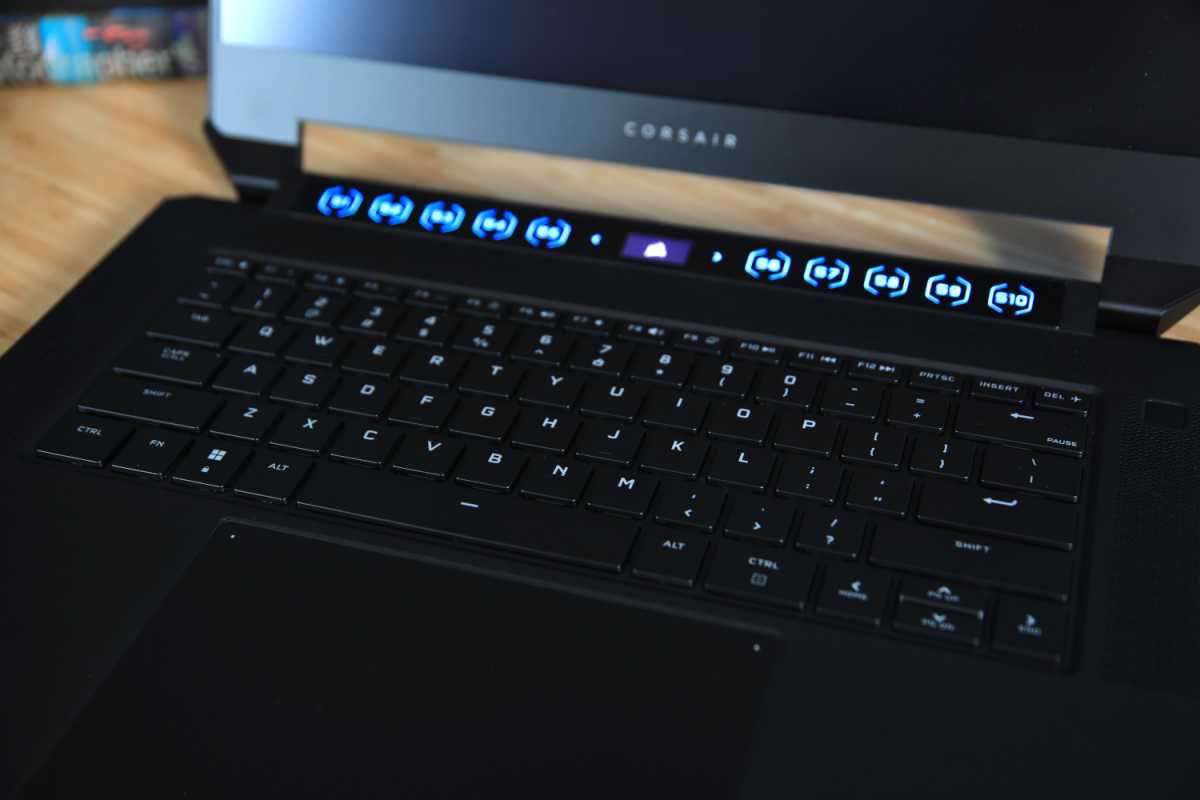
IDG / Matthew Smith
The Corsair Voyager a1600 has a mechanical keyboard with Cherry MX Ultra-Low Profile (ULP) switches. They offer a distinct key feel that is deeper, more tactile, and more distinct than usual. Keys bottom with a tactile, clicky action that leaves no doubt a key is depressed.
Is it better than a scissor-switch keyboard? Not necessarily. I’m happy with the keyboards found on laptops like the Apple MacBook Air M2, Dell XPS 13, and Lenovo ThinkPad Carbon series, to name a few. Still, there’s no denying the Voyager’s keyboard is good, and the key feel immediately stands out as different from a scissor switch design.
The keyboard layout is good, as well. Corsair chooses to omit the numpad for a design that’s centered above the touchpad and offers large, easy to reach keys. Even the function keys are a bit larger than most laptops, though still about half the size as those on most desktop keyboards.
Corsair throws in a set of LED-backlit, touch sensitive buttons above the function keys (offically called “S-Keys”). These target streamers and are meant to allow easy scene transitions, like a built-in version of Elgato’s fantastic Stream Deck (Corsair owns Elgato). I’m not a streamer, so I can’t say for sure whether they’re useful—but I have my doubts. Touch sensitive function bars on laptops don’t have a great track record. They tend to be hard to locate by touch and too far from the user’s hands. The Voyager doesn’t have any tricks to counter those problems.
Backlighting comes standard and supports Corsair’s iCUE, which makes changing the backlight easy. It’s also possible to sync with other iCUE devices. This certainly gives Corsair when it comes to customization.
The Voyager a1600 has a massive touchpad that measures over six inches wide and about four inches deep. This is a behemoth by Windows standards and on par with Apple’s MacBook Pro 16. Touch input is responsive and multi-touch gestures feel great. It’s among the best Windows touchpads available right now, rivaling the Dell XPS 17, and way above average for a gaming laptop.
Display, audio
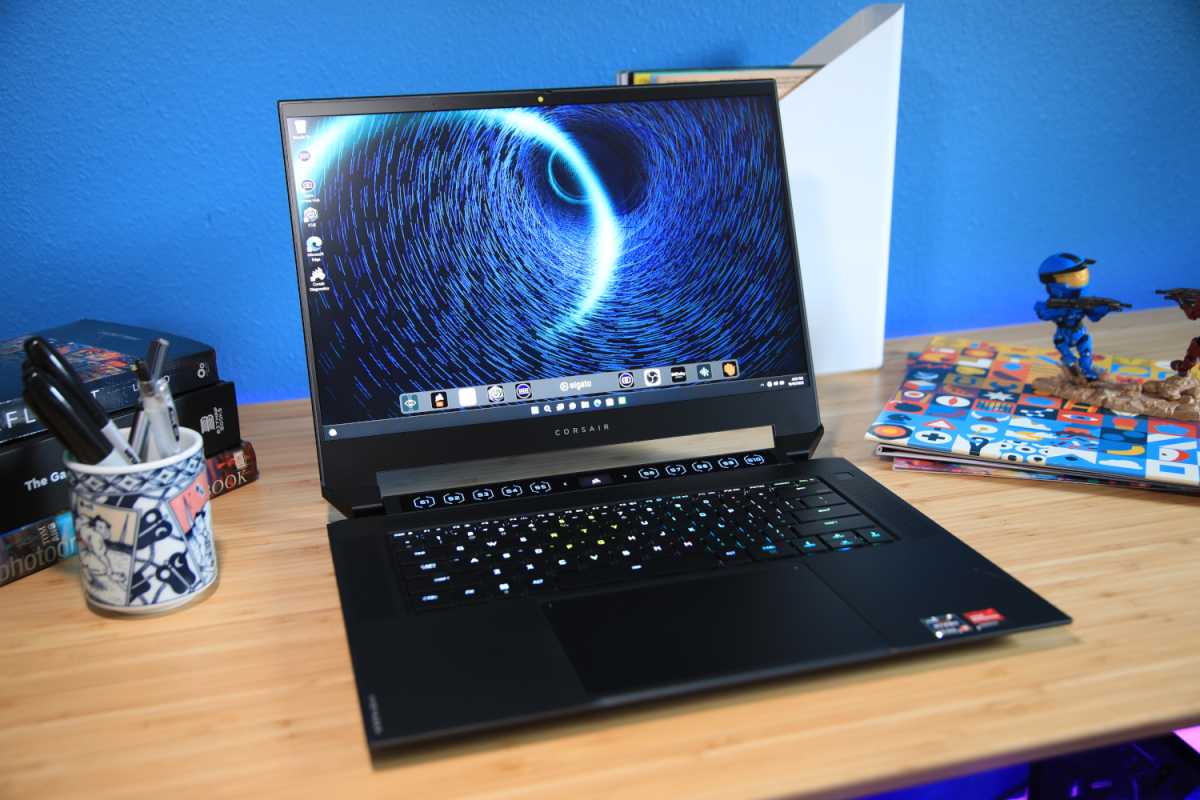
IDG / Matthew Smith
The Corsair Voyager a1600’s display is a bit unusual. It measures 16 inches but has a 16:10 aspect ratio, which is taller and closer to square than now-traditional 16:9 screens. This is an increasingly popular move among many laptops, but the added size is especially notable on a large display like that found here.
16:10 is great in productivity, since it’s easier to arrange two or four windows in a way that’s useful. It’s also handy in games with numerous interface elements. This includes grand strategy games like Crusader Kings 3 and MMORPGs like Final Fantasy XIV. On the flip side, it provides less benefit to first-person shooters or simulation games.
Image quality is unremarkable, as the a1600 has a standard IPS panel without a Mini-LED backlight. Maximum brightness reaches a respectable 379 nits, but elevated black levels means the contrast ratio is limited to a maximum of 1060:1. Dark scenes look hazy and can lack detail in shadows.
The Voyager a1600 also has a modest color gamut, reaching just 80 percent of DCI-P3. This is a problem. It means the a1600 can display less colors overall and skews towards a less vibrant presentation. Color accuracy is decent, so the problem is not that the image is wildly inaccurate. However, gamers have become accustomed to the ultra-saturated look of wide gamut displays. The a1600’s seems dull and washed-out by comparison.
These traits also make the Voyager a1600 unsuitable for demanding creators working with photos, video, or digital art. The display lacks the resolution and color gamut these owners will demand. That’s a big miss, I think, because many streamers are also creators elsewhere and are more likely to need these advantages.
The display has a maximum refresh rate of 240Hz and works with AMD FreeSync to provide smooth frame pacing. This combination works rather well in practice. Motion looks smooth and fine details are often visible. When scrolling through a scene in League of Legends, for example, characters and health bars are easy to see, though names remain difficult to read.
Audio quality is underwhelming. The Voyager a1600 benefits from its upward-firing speakers, which keep audio clear and provide acceptable volume. That’s all the praise I can offer, though, as maximum volume isn’t loud and the lower end is missing in action. Music and games sound tinny, distinct, and a bit harsh, as the mid and upper range dominates the presentation. Most gaming laptops offer a higher maximum volume and more bass.
Webcam, microphone, biometrics
Corsair packs a 1080p webcam and four-array microphone into the Voyager a1600 which, at a glance, seems impressive. Yet it doesn’t hold up under scrutiny. Video still looks grainy and dull, especially in low to moderate lighting. The camera only works great with some form of direct lighting, such as a ring light. Is it better than 720p? Yes, absolutely—but it’s not better than other 1080p laptop webcams.
The microphone, meanwhile, was very disappointing. Audio volume was good, and the microphone was able to pick up my voice well when I turned my head away from the laptop. The quality is hollow, distant, and generally not pleasant to listen to. I’d call it functional at best.
A physical privacy shutter is included and toggled using a manual flip slider in the laptop’s bezel. This is a great feature. It’s easy to see if the privacy shutter is in place, and there’s no way to open it electronically.
The laptop supports biometric login through both a fingerprint reader and an IR camera. The fingerprint reader is reliable but can be followed by even a slightly damp, sweaty, or dirty hand (so keep your hands out of the Doritos!) The IR camera’s facial recognition is faster and always works, so it’s the better way to log in. The camera works even in a dark room and can be set up to recognize users with glasses on or off.
Connectivity
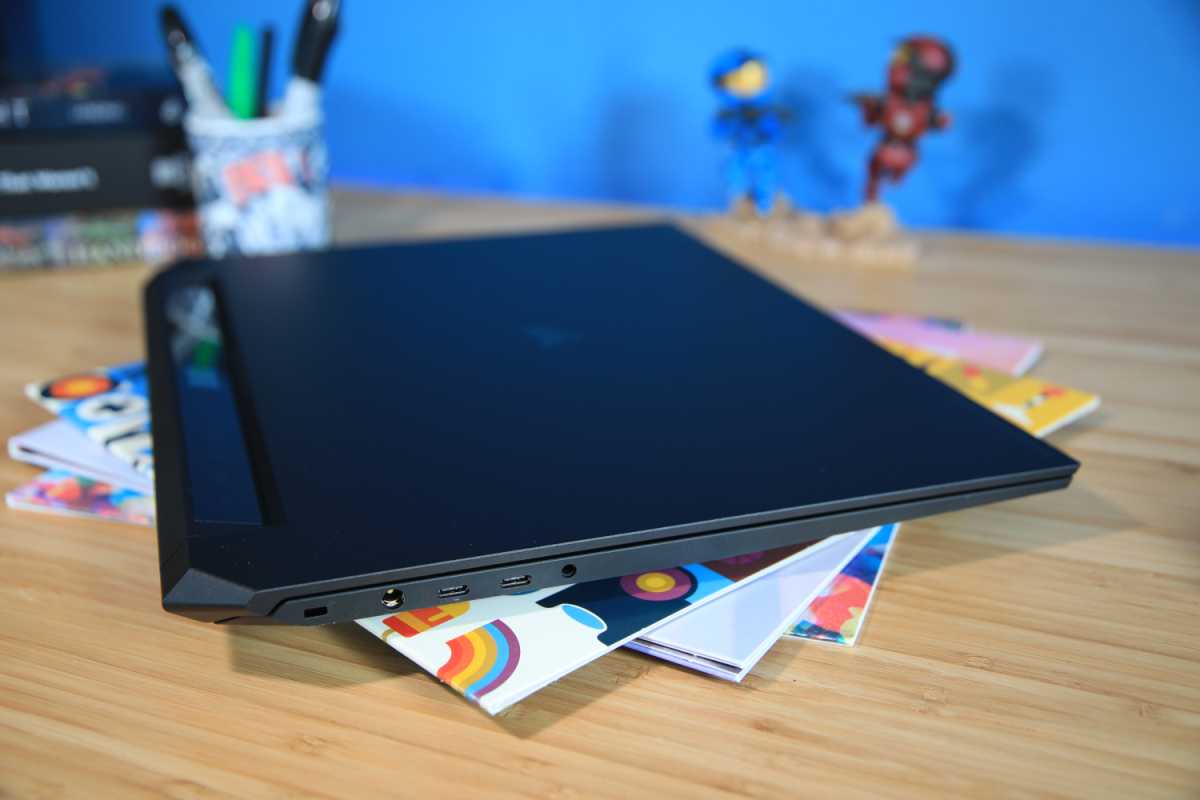
binary comment
IDG / Matthew Smith
The Corsair Voyager has two USB4 ports alongside one USB-C 3 port, for a total of three USB-C ports. These ports do not support Power Delivery, however, so they can’t charge the laptop. This is a small disappointment, though mitigated by the fact USB-C would not normally be able to provide enough power for this laptop, which has a 230 watt power adapter. It is technically possible to deliver that over the latest USB Power Delivery standard, but I’ve yet to test a laptop that offers it.
Thunderbolt 4 is also missing, as is common on laptops powered by AMD hardware. This, again, is only a minor disappointment, but it may lead to less impressive storage performance overall. Corsair isn’t specific about the bandwidth of its USB-C 4 ports.
It’s great to see Corsair include a full-sized SD card slot. This is becoming more common after years of absence on premium laptops, but it’s particularly useful for the Voyager a1600. It’s meant for streamers and creators, who may need to use a DSLR for photo or video. The SD card slot allows quick transfers without an adapter.
Wireless connectivity is excellent with support for the latest WiFi 6E standard. I don’t currently have a WiFi 6E router for testing, unfortunately, but WiFi 6 performance was also excellent, routinely hitting 70MB/s while downloading from Steam. Bluetooth 5.2 rounds out wireless connectivity, providing the highest level of support for Bluetooth audio devices.
The Voyager a1600 has a built-in Corsair Slipstream wireless transceiver, which can be used for low-latency wireless connections to other Corsair wireless devices. I didn’t have any Corsair devices to test it with. Speaking generally, however, I’d expect this to prove a bit more reliable, and to have a longer usable range, than Bluetooth.
Performance
The Corsair Voyager a1600 I tested was a top-tier model with an AMD Ryzen 9 6900HS processor, AMD Radeon RX 6800M 12GB mobile graphics, 32GB of DDR5 memory, and a 2TB PCIe Gen 4 solid state drive. This is the top of AMD’s mobile product stack. So, how does it perform?
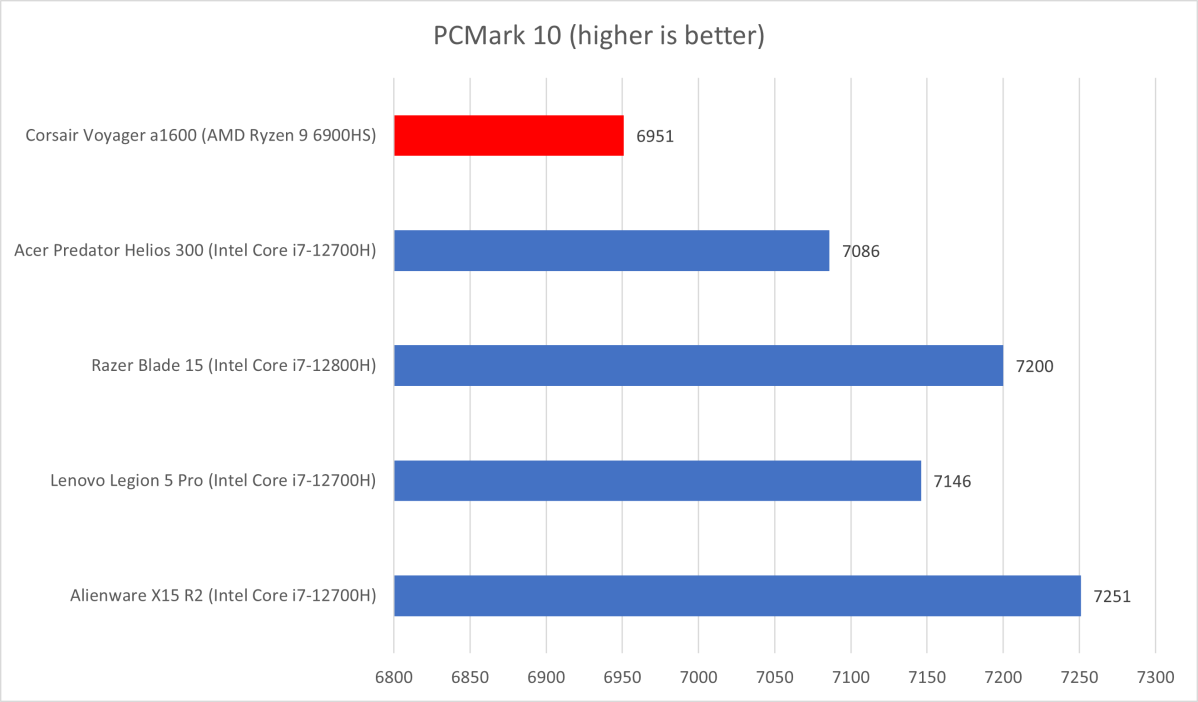
IDG / Matthew Smith
We start with PCMark 10. Technically, this is a loss for the Voyager a1600, as it brings up the rear against other laptops in this competitive set. Look closer, though, and the difference is trivial. All of these laptops do well overall and beat smaller and/or less expensive alternatives.
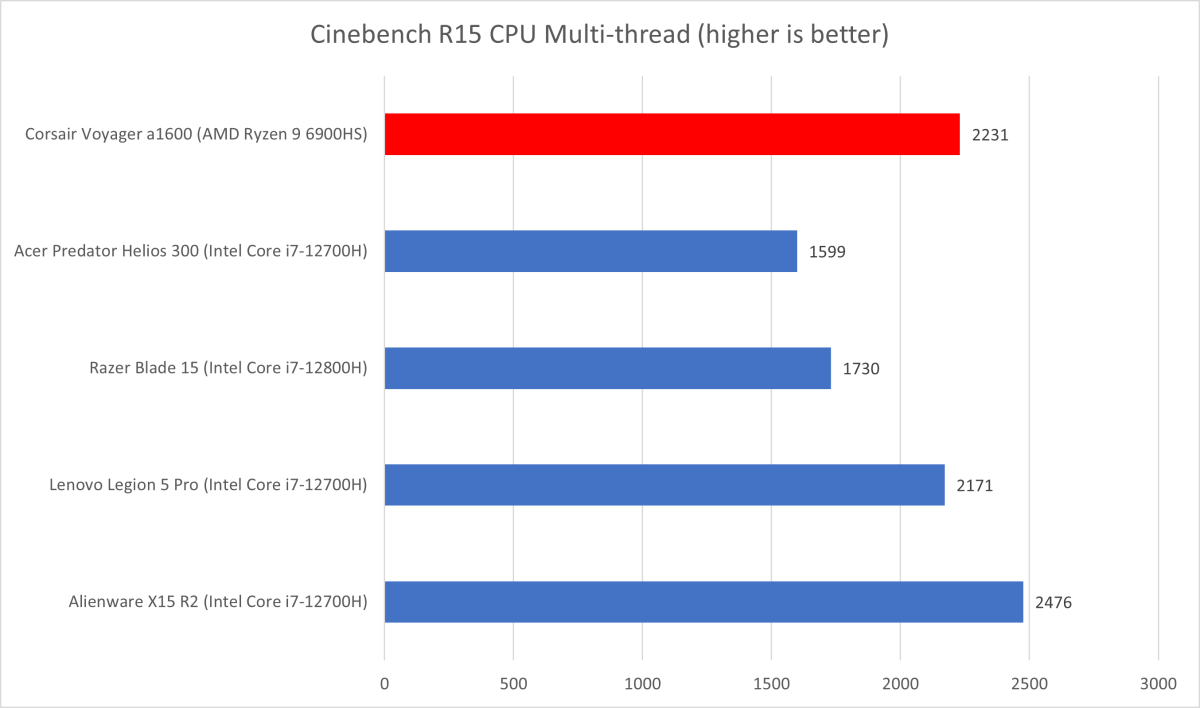
IDG / Matthew Smith
Next up is Cinebench R15 multithreaded, a benchmark that greatly prefers excellent many-core performance. The Voyager a1600 does very well here, beating all laptops aside from the Alienware X15 R2, which manages a small lead. All of these scores are good, but there’s a wider ranger here than in PCMark 10, and it shows that a laptop’s thermals and performance profile contribute significantly to how it will perform in benchmarks.

IDG / Matthew Smith
Handbrake rounds things out with a lengthy test that requires over 13 minutes for even the fastest laptop to complete. The Voyager a1600 is exactly mid-pack, landing just behind the Alienware X15 R2. Aside from the Razer Blade 15, which does not hold up well here, the gap between laptops remains small.
The Voyager a1600’s AMD Ryzen 9 6900HS processor puts up a good fight. It can’t beat Intel alternatives, but it certainly goes toe-to-toe, and does so at pricing similar to the competition. That’s enough to keep it in the fight.
We’ll now dive into graphics performance, and here I must add an important caveat: I will be showing results for both the Balanced and Extreme mode. I personally do not consider an Extreme mode to be very useful in a laptop, since it’s often so loud and hot that it’s impractical in real-world use. In this case, however, the gap between each mode is remarkably large, so both results are required to get the full story. The same is not true in processor benchmarks. The Extreme mode does provide a tiny advantage in those tests, but it’s just a few dozen points (or seconds) in its favor.
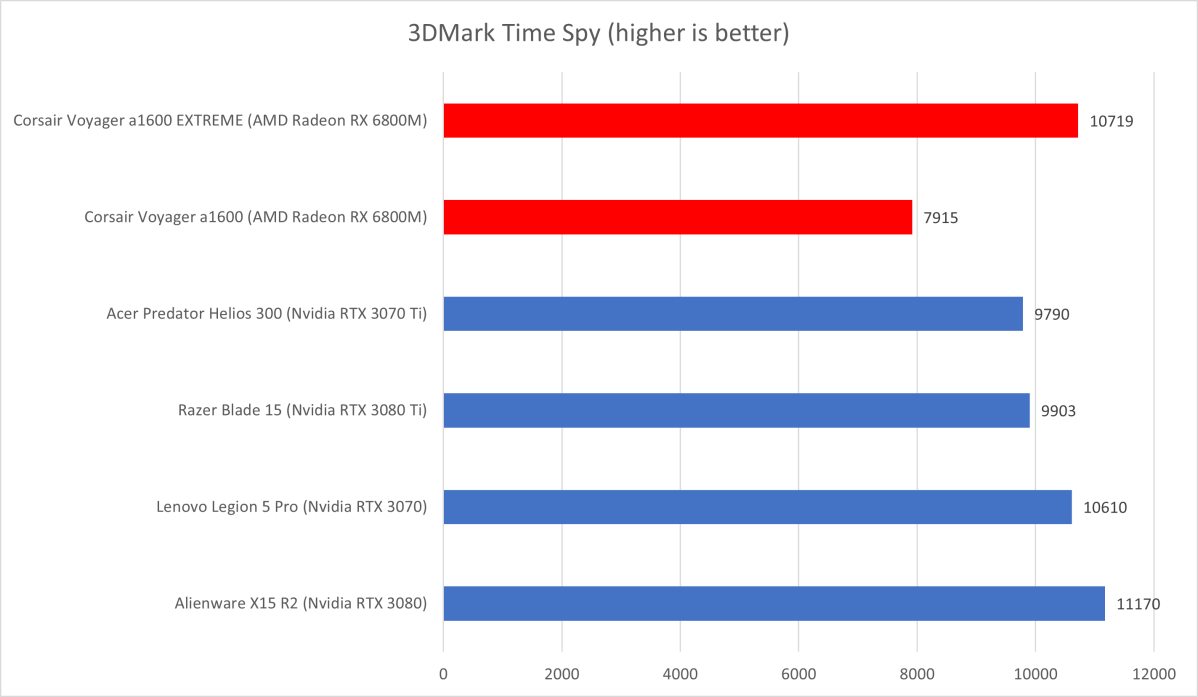
IDG / Matthew Smith
Okay, let’s start with 3DMark Time Spy, which immediately shows the massive gap between Corsair’s Balanced and Extreme modes. The Voyager a1600 puts up a great fight in Extreme mode, beating all competitors except the Alienware X15 R2. However, Balanced mode is a different story, and it ends up finishing way behind the alternatives.
Keep in mind that the competitor scores shown here are for their respective default modes, which is typically a “Balanced” mode, or similar. In short, this is not a good result for Corsair.
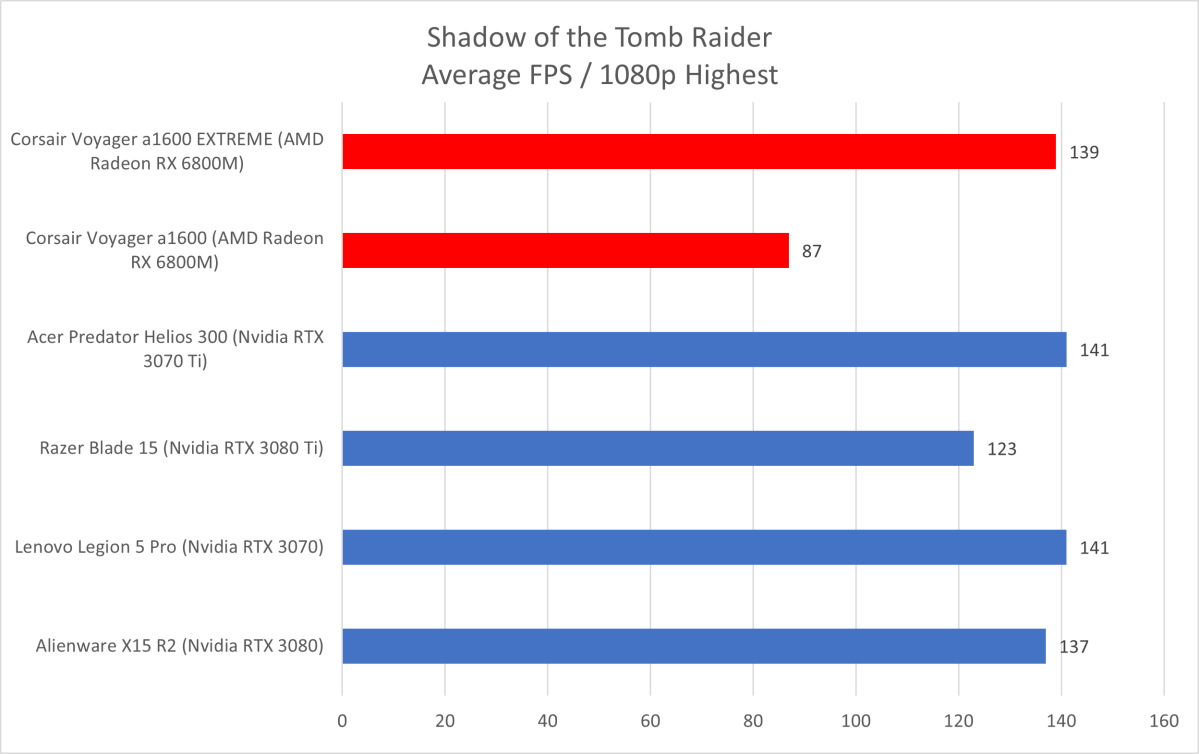
IDG / Matthew Smith
The trend continues in Shadow of the Tomb Raider. Here, the Voyager a1600 again performs very well in Extreme mode, standing toe-to-toe with Nvidia RTX 3070 Ti, RTX 3080, and RTX 3080 Ti laptops. In the more usable balanced mode, however, the Voyager a1600 falls far behind, delivering a mere fraction of the expected performance.
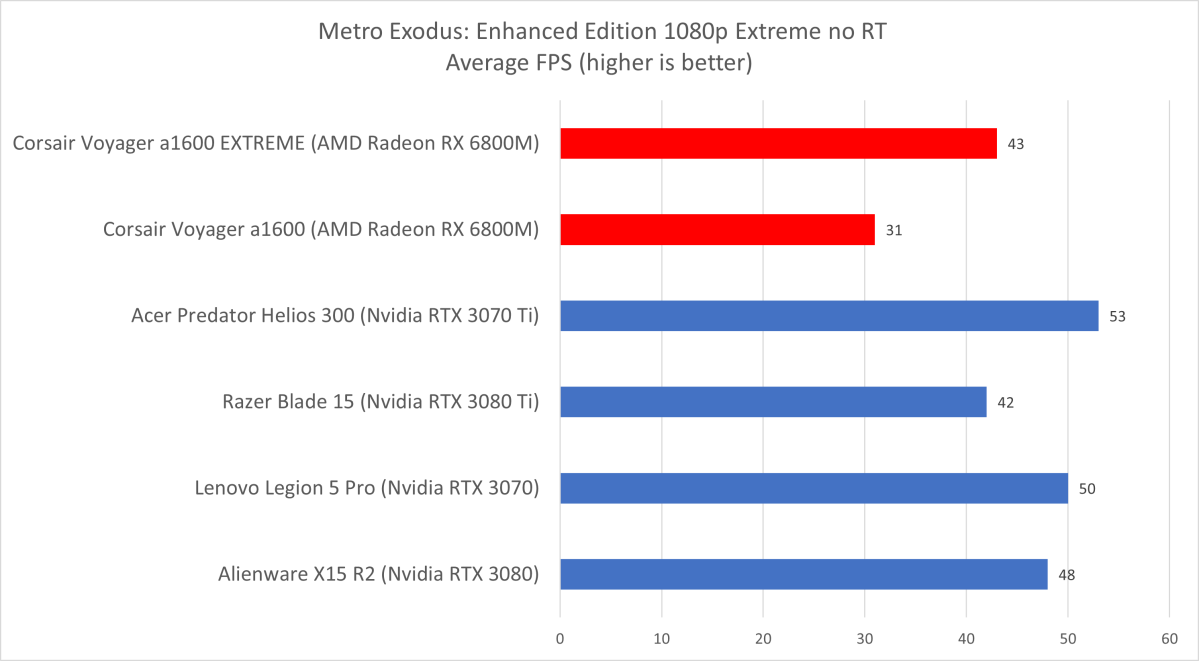
IDG / Matthew Smith
Metro Exodus remains on trend. The Voyager a1600’s results are far below expectations in Balanced mode but leap into contention with Extreme Mode active. Even then, however, the Voyager a1600 is on the low end of the performance spectrum.
I tried the Voyager a1600 in a variety of other games ranging from older, less demanding titles like Final Fantasy XIV to the latest, cutting-edge games, like Cyberpunk 2077. The trend was always the same.
Clearly, the Corsair Voyager a1600’s performance is heavily influenced by the mode used. It can’t keep up in Balanced mode but holds up well in Extreme.
That’s a problem, because Extreme mode is way too loud. The constant whirr is easy to hear even when using over-ear headphones. I can’t imagine putting up with it while gaming (or streaming).
Corsair might have a fix for this. The company plans a BIOS update to add a Gaming mode that sits between the Balanced and Extreme modes. This mode slightly reduces the AMD SmartShift combined power target from 147 watts to 135 watts. It’s not yet available, though, so I couldn’t test it.
Battery life
The Corsair Voyager a1600 goes all-in on battery size with a 99 watt-hour unit. This is the maximum the FAA will let passengers carry on a plane, so it’s the effective hard limit for battery size.

IDG / Matthew Smith
Battery life comes in at four hours and 55 minutes. That’s not excellent, of course, and certainly far short of a full work day. However, this level of battery life stacks up well in the realm of high-end gaming laptops. The Voyager a1600 is mid-pack, and that’s not a terrible place to be.
There is a quirk to note, however: the Voyager a1600 can feel a bit hesitant when used on battery power. This seems due to a delay in switching between AMD’s integrated and discrete graphics.
The Voyager a1600 will use the Ryzen 9 processor’s integrated graphics in less demanding workloads, switching to the Radeon RX 6800M. Opening a program can cause a hitch or stutter as the system works out which display mode it’s supposed to use. Disabling switchable graphics in the laptop’s BIOS resolves the issue but will also decrease real-world battery life.
Conclusion
The Corsair Voyager a1600 is an imperfect but promising introduction to the laptop market. It stands out from the crowd with its large 16-inch, 16:10 display, mechanical keyboard, massive touchpad, and use of AMD hardware for both CPU and GPU. The S-Key bar and LED screen also add flair, though they’re a bit lacking in function.
Unfortunately, the Voyager a1600 feels like what it is: a first attempt from a company new to laptops. The decisions made for its performance profile are odd so, depending on the mode you choose, the laptop either underperforms the competition or howls like a rabid animal. The laptop falls short of expectations in display, audio, webcam, and microphone quality, and the port selection is so-so.
Corsair’s first laptop may appeal to streamers and gamers who crave a quality keyboard and touchpad, or those who appreciate its large 16:10 display. For most, however, game performance is key, and that’s where the Voyager a1600 has trouble. It technically can perform well, but only when the fans scream like a banshee. Alternatives like the Acer Predator Helios 300 and Lenovo Legion 5i can deliver the same or better, with less drama (and at a lower price).
For all the latest Technology News Click Here
For the latest news and updates, follow us on Google News.
